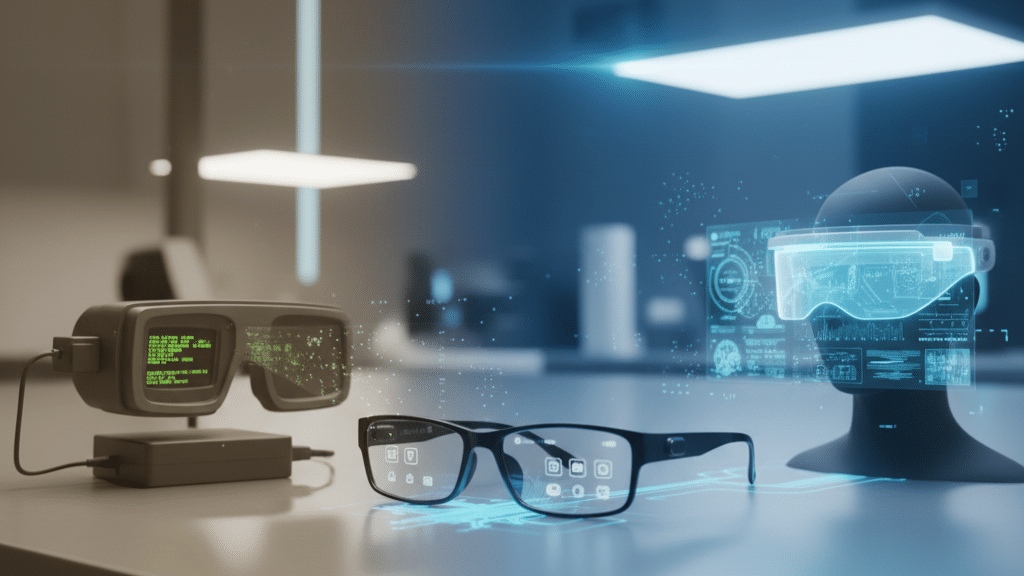Smart glasses have long promised to merge the digital and physical worlds — to let us see information without looking away from life. But that promise has taken decades of experimentation, reinvention, and persistence to get where we are today.
🕰️ From Early Experiments to Google Glass
The story begins in the 1990s with bulky prototypes built by researchers like Steve Mann, often called the “father of wearable computing.” These early systems were visionary but far from practical — heavy headsets tethered to backpack-sized computers.
Then, in 2012, the world got its first real glimpse of consumer smart glasses: Google Glass. Unveiled with skydivers streaming live video during a Google I/O keynote, it was both futuristic and controversial.
Glass never reached mass adoption due to privacy concerns, limited functionality, and its high price tag. Yet it planted a seed — showing what was possible when digital data met the human gaze.
🕶️ The Second Wave: AR Ambitions
The years that followed saw the rise of augmented reality (AR) as the driving force behind the next generation of smart eyewear.
- Microsoft entered the scene in 2015 with HoloLens, focusing on enterprise and industrial applications. HoloLens demonstrated the power of AR for design, training, and maintenance — less a gadget, more a professional tool.
- Magic Leap, founded in Florida, captured imaginations (and billions in funding) with its mysterious light-field technology, though its early products struggled to find a market.
- Snap introduced Spectacles, a playful approach centered on short-form video and social creativity — early steps toward blending fashion with function.
🌐 The Tech Giants Join the Race
By the early 2020s, nearly every major tech and consumer-electronics company had turned its gaze to smart eyewear — devices that not only look like regular glasses but are embedded with sensors, displays, AI assistants, and connectivity.
Meta (Facebook)
Meta leads the current market. Its collaboration with EssilorLuxottica has produced the Ray-Ban Meta line of smart glasses, combining fashion with functionality and representing roughly 70% of global sales in 2025.
Beyond that, Meta is developing the next generation of AR-enabled glasses, featuring built-in displays, AI-driven voice and vision tools, and seamless integration with its Quest ecosystem.
Apple
Apple has yet to launch a mainstream pair of smart glasses but is reportedly working on lightweight AR eyewear building on the technology and design foundations of Vision Pro.
With its strengths in hardware, custom silicon, and the Apple ecosystem, its entry is expected to redefine the category.
A pioneer turned comeback player, Google has re-entered the space with its Android XR platform — a foundation for headsets, AR glasses, and other extended-reality devices.
Google is partnering with brands like Warby Parker and OEMs to deliver stylish glasses powered by Gemini AI. Its vision is not a single product but a broad ecosystem of compatible devices.
Samsung
Leveraging its expertise in displays and semiconductors, Samsung is developing new AI-powered smart glasses (internal codename “Haean”) in collaboration with Google’s Android XR initiative.
Amazon
Amazon’s projects — codenamed Jayhawk (consumer) and Amelia (logistics) — are in active development, with launches expected in 2026–2027.
The company aims to integrate Alexa and its AI services into natural, voice-first glasses connected to its e-commerce and logistics ecosystem.
Lenovo
Lenovo remains a major player in enterprise AR with its ThinkReality A3 model, targeting professional environments like field service and design visualization.
It’s also investing in optical-engine development, building toward consumer-grade AR eyewear.
Huawei, Xiaomi, OPPO, and Xreal
Chinese manufacturers are pushing innovation fast. Huawei Eyewear II, Xiaomi, OPPO, and Xreal (formerly Nreal) are creating lighter, more stylish AR glasses — some with projection-based displays and deep smartphone integration.
Others
Vuzix and Magic Leap continue to serve industrial and enterprise markets, while Snap, Rokid, and other startups explore creative and entertainment-focused use cases.
🧠 The New Frontier: AI and Everyday Use
The biggest shift today is context. Advances in AI assistants, on-device processing, and lightweight optics are finally making smart glasses useful and natural.
Devices like Ray-Ban Meta and Xreal Air 2 Pro show how far the field has come: lighter, voice-responsive, affordable, and increasingly capable.
The line between smart glasses, AR headsets, and AI wearables is blurring fast. Soon, users will read messages, translate speech, or identify landmarks — all through a simple glance.
🔭 What Lies Ahead
The next five years will define the category. Expect Apple, Meta, Google, Samsung, and Amazon to lead mainstream adoption, while Xreal, Lenovo, and Vuzix push the limits of optics, gesture control, and interface design.
If the 2010s were about proving the idea, the 2020s are about perfecting the experience.
The race isn’t just about what we’ll see — but how we’ll see it.


Leave a Reply